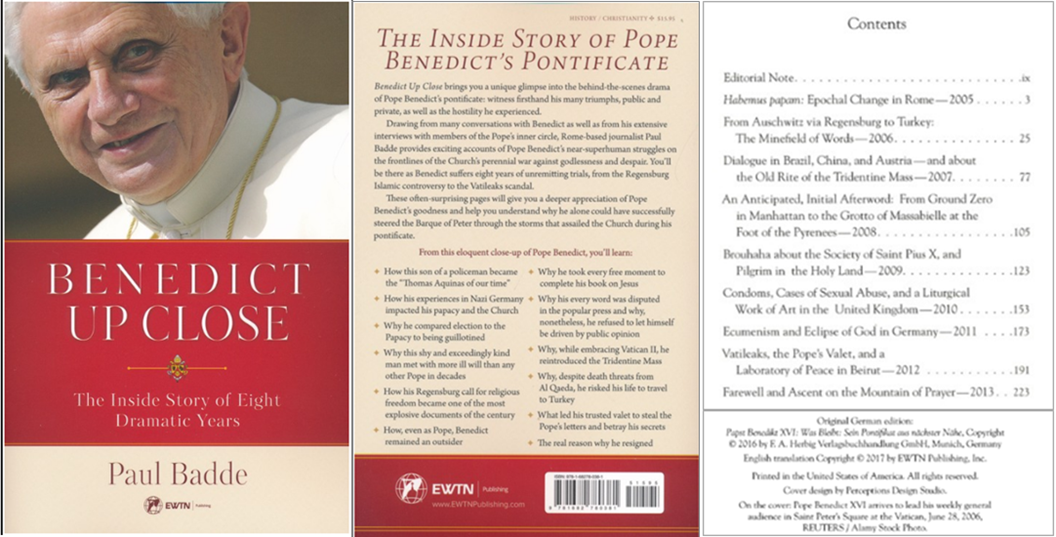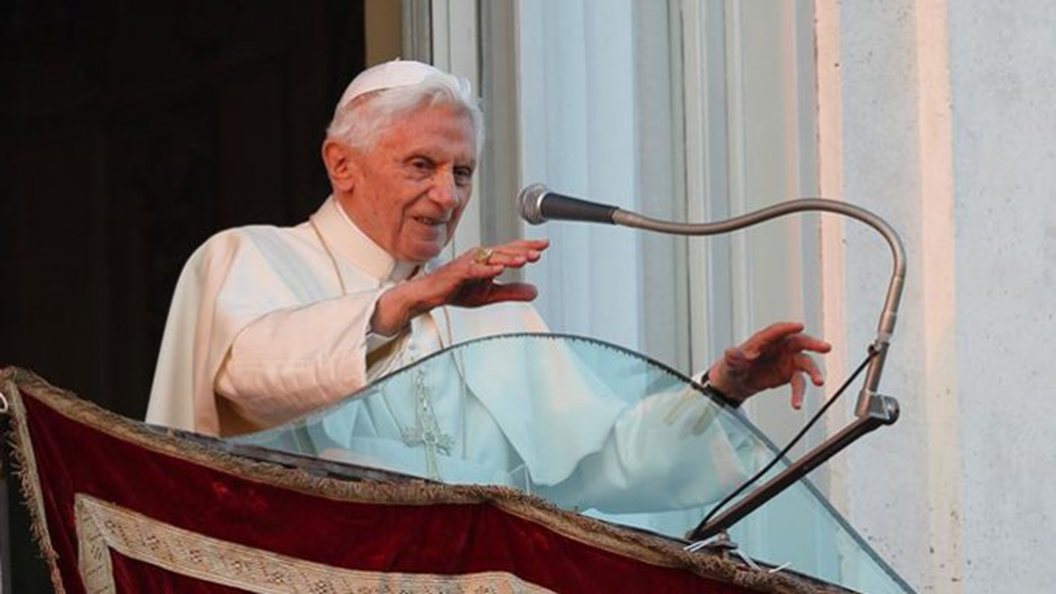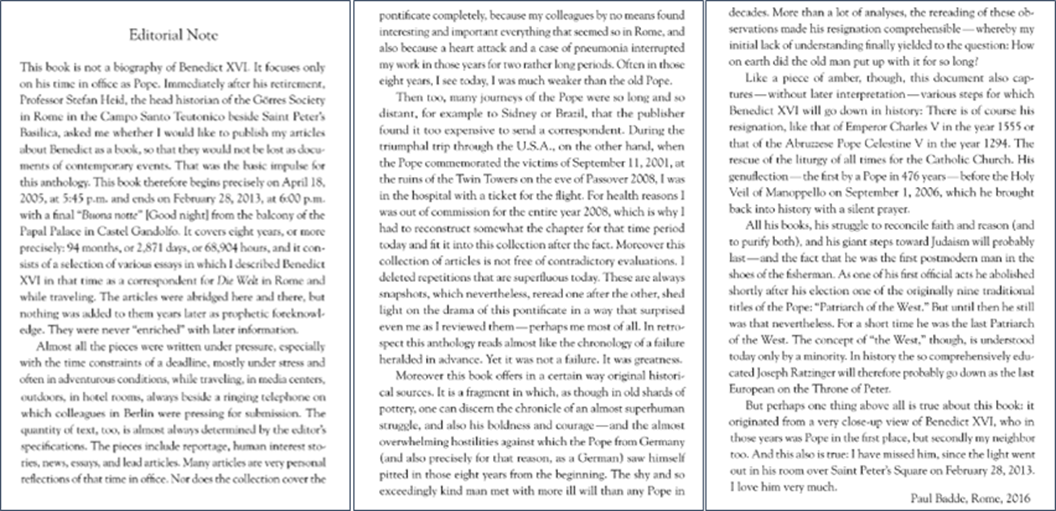
BENEDICT UP CLOSE:
THE INSIDE STORY OF EIGHT DRAMATIC YEARS
By Paul Badde
Translated by Michael J. Miller
EWTN Publishing Inc., 2017
208 pages, $15.95, paperback ($9.95 e-book)
To order: ewtnrc.com or (800) 854-6316
The original edition of this book in German was published in 2016 but I do not recall having read about it at all. And now that EWTN has published the English version, I have seen only two reviews of it so far, which I find exceedingly strange.
A journalist’s “inside look” at the papacy of Benedict XVI
Paul Badde’s new book tells the story of a dramatic papacy as it unfolded
By Paul Senz

Sept.19, 2017
A new book by Paul Badde, entitled
Benedict Up Close: The Inside Story of Eight Dramatic Years (EWTN Publishing, 2017), takes a novel approach to a retrospective on the pontificate of Benedict XVI. Badde, a German journalist who was a Rome correspondent for
Die Welt for many years, has collected articles and essays on the papacy of Benedict XVI written during that papacy. Rather than an attempt to assess in hindsight, this is a look back on what was said at the time.
This provides an interesting insight into the Benedict XVI years. How did journalists react when Joseph Ratzinger emerged onto the central loggia of St. Peter’s Basilica as the new pope? What was being said about the now-infamous “Regensburg address” at the time it was given? The many controversies that swirled around the pope may seem static in our memories—but how were they perceived as they were actually happening?
In the style typical of European journalists, these pieces often present behind-the-scenes information without attribution. Italian Vaticanistas are well-known for this, and Badde is in this same camp.
The tone of many of the essays in the book is intimate; one can tell that Badde had his own personal relationship with Joseph Ratzinger. Badde is writing of a man he truly loves, a shepherd he considers his own.
In Badde’s piece from February 11, 2013, the day that Benedict announced to the assembled cardinals and the world that he intended to renounce the Petrine office, Badde’s love for Benedict and his shock at the announcement are palpable.
“[He] is not resigning,” Badde wrote, “but rather freely going ahead into the inner sanctum of the Church’s prayer. It is incomprehensible and unprecedented, but I don’t care. It is just sad. It sticks like a lump in the throat. […] It is enough to make you weep.”

These are the words of a man crushed by the end of a pontificate with which he was intimately tied.
Benedict Up Close is an interesting read for those who are ready to take another look at the papacy of Benedict XVI as it unfolded. Time will tell what long-term effects Joseph Ratzinger will have had on the Church. But if the reader is seeking to experience his pontificate all over again, this is the book.
Chronicling Benedict XVI
By John M.Grondelski

October 7, 2017
A set of essays
[reportage, really!] Paul Badde originally wrote for the German daily
Die Welt during the eight years of Benedict XVI’s pontificate, Benedict Up Close discusses
not so much what Benedict did as why he did it and why it mattered.
The book is not strict history, although its order is chronological. Badde’s essays touch all of the pontificate’s major moments: its beginnings, his pilgrimages (especially to Germany and the Holy Land), his encyclicals and other instructions, his ecumenical and interreligious gestures (including the Regensburg address), his attempt to reconcile the schismatic Lefebvrists, his efforts on sexual-abuse cases, his “reform of the reform” of the liturgy, and his resignation.
Looking back at these texts, Badde’s perspective was often spot on and uncanny. (I reserve judgment on all his enthusiasm about the Veil of Manoppello or some of his more positive waxings about the “German hour” in the Church under Benedict).
If one is searching for a meta-theme to Benedict’s pontificate, it is rediscovering the human face of God in Jesus Christ.
Catholicism is about a Person, not a proposition, a Person in whom the modern world’s faith is waning. Benedict understood his papacy not so much as one of administration or responding to the crises of the day, but about “Jesus Christ, yesterday, today and forever,” for whom the Petrine ministry exists to confirm the faith of his brothers.
That is why, says Badde, Benedict sought to reform the liturgy as the privileged place of sacred encounter with Christ. That is why he sought to surmount the false dichotomy that tries to split the “post-Vatican II” Church from the “pre-Vatican II” Church, forgetting that there is but one Church of Jesus Christ, bound together by a “hermeneutic of continuity.”
And that is why Benedict devoted much of his spare time to his book Jesus of Nazareth.
[Spot-on resume of B16’s Pontificate which underlines the abysmal difference with the current pontificate whose priorities are not just the polar opposites of Benedict XVI’s but nothing less than a betrayal of the primary mission of the Successor of Peter.]
The author calls Benedict the first “postmodern” pope (though I would argue that John Paul II was hardly unaware of the intellectual shoals of modernity). As a modern German, he is aware not just of the divide between Catholics and Protestants in his homeland, but of the “totalitarian secular worldview” of today’s Europe, as well — “the old front in the religious wars have long since taken a new course. [In Germany] it is no longer the Catholics and the Protestants who stand in opposition to one another. In the East, after two dictatorships on German soil, only a very few of them have remained, making way for a complacent majority of nihilists and neopagans.”
Yet while Benedict’s critics — including many in the Church in Germany — brand him “too conservative” (as if such terms were appropriate to the faith), Benedict sought to reintroduce modern people to Christianity or, more precisely, to Christ. Badde’s essays offer a thought-provoking assessment of the great challenge of faith that Benedict presented.
Badde’s introduction to his book:
 Having lifted the above from preview pages made available on the Googlebooks presentation of the book, taking screenshots was the quickest way to reproduce it. The preview also includes Chapter 1.
Having lifted the above from preview pages made available on the Googlebooks presentation of the book, taking screenshots was the quickest way to reproduce it. The preview also includes Chapter 1.